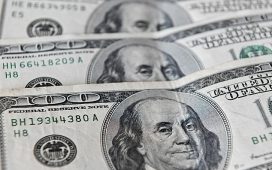This article is an on-site version of our Unhedged newsletter. Sign up here to get the newsletter sent straight to your inbox every weekday
Good morning. Dick’s Sporting Goods lost a quarter of its value yesterday when it cut its outlook, saying theft is up and unpopular inventory had to be pushed out the door (in a better world, these two trends would cancel each other out, but not in our world). The economy is not strong everywhere. Email us: robert.armstrong@ft.com and ethan.wu@ft.com.
Inflation and unionisation
The strongest way to make the case that inflation will keep falling is by working from the bottom up — that is, by looking at each component of the price index, and then drawing conclusions about the index overall. Start with shelter. Private market data suggests rental inflation should fall a lot. Next, used vehicle prices have gone nuts but are now turning over. And outside of these two categories, inflation looks tame. Here’s that argument in one picture:

(If you want all the gory details, Skanda Amarnath at Employ America had a nice post earlier this month.)
Making the argument from the top down — that is, starting with the macroeconomy — is tougher. Historically, wages tend to set a lower bound on how much inflation can fall. In the past century, the two variables have rarely travelled more than a percentage point or two apart, as Matt Klein of The Overshoot has pointed out. His chart:
Wage growth is now elevated by any measure, with the Federal Reserve’s favourite gauge, the employment cost index, running at 4.6 per cent, compared with about 3 per cent in 2019. So it’s hard to see how inflation returns to 2 per cent.
Matching the wage growth data is another indicator we looked at back in December: union activity. Then, we noted an uptick in strikes and labour protests. It hasn’t quieted down. July marked the largest number of US workers on strike in one month since January 2021, according to Cornell’s labour action tracker.
This could matter to inflation. One study last year by two Fed economists argued that inflation’s structural decline since the 1980s is largely attributable to the decline in worker bargaining power. Even today, US regions with higher union density experience a sharper inflation-unemployment trade-off, they find. The authors quote the late economist James Tobin:
Inflation is the symptom of deep-rooted social and economic contradiction and conflict. There is no real equilibrium path. The major economic groups are claiming pieces of pie that together exceed the whole pie. Inflation is the way that their claims, so far as they are expressed in nominal terms, are temporarily reconciled. But it will continue and indeed accelerate so long as the basic conflicts of real claims and real power continue.
Behind today’s surge in labour action is a combination of a tight labour market raising employee leverage and the pandemic’s stark reminder that working conditions matter, said Candace Archer, policy director at the AFL-CIO union federation. She adds that inflation is better attributed to high corporate profits and supply-side disruptions than wage growth.
Wall Street is noticing. As Dan Clifton of Strategas wrote in a July note called “Worker strikes are becoming a macro issue”:
Strikes receiving more attention makes sense, with four new strikes authorised in the last month . . . We got the sense from investors that the issue was less about economic disruption from the strikes, but that the strikes will result in large pay increases. I celebrate American workers getting paid more, but two dominant discussion points of these pay increases are: 1) Margin compression for companies and 2) Future inflation.
Ian de Verteuil, head of portfolio strategy at CIBC, is concerned by the wage agreements embedded in existing union contracts. He says these provide a unique glimpse into companies’ willingness to pay for labour, because they require multiyear commitments signed upfront. Using a Bloomberg Law contract database, wage increases pencilled in for the average contract’s third year are above 4 per cent, and rising:
Of course, only 10 per cent of US workers are unionised and Bloomberg Law’s data isn’t all-encompassing (covering about 350,000 workers). But de Verteuil argues union contracts’ “quasi-public nature” lends them “disproportionate impact on employee wage expectations”.
Other data shows those expectations rising. The New York Fed’s thrice-yearly survey of consumer expectations includes a question about the “reservation wage”, the lowest annual wage the average respondent would be willing to accept for a new job. The latest survey, published on Monday, showed record wage expectations of $78,600. The increase since March 2020 has outstripped inflation:

Should Wall Street worry about unions? Says the AFL-CIO’s Archer: “Maybe they should. If you keep doing things unfairly, people will organise to change that.” (Ethan Wu)
Is Goldman cheap?
Yesterday I wrote about how everyone at Goldman is angry with the CEO, David Solomon, nominally because he is not very nice. Writing the piece got me thinking about whether Goldman might be undervalued.
I am struck by how good Goldman’s historical performance has been relative to peers. According to RBC, Goldman’s total shareholder return is second among large banks over 20 years (8.4 per cent compound annual rate), fifth over 10 years (9.3 per cent) and second over five (10 per cent). In growth in book value per share and dividends, it is number one over five and 20 years, and number two over 10.
Why has it done so well? Because its franchises in investment banking and trading are market-leading, and in finance, big incumbents are very hard to dislodge (as Goldman discovered when it tried consumer banking and got nothing but a big, expensive bloody nose). And you can get these franchises for 1.1 times book value and 12 times earnings.
The main reason for the limp valuation is volatility of results. Here is the annual change in Goldman’s net income compared with that of JPMorgan Chase:

People will pay more for steady, predictable earnings. But if you are a long-term investor, this is stupid, as Warren Buffett has taught us. At a company with a sustained economic advantage, all that that earnings and share price volatility does is offer good prices at which to buy and sell.
That said, investors are not going to suddenly become more rational and start paying a richer valuation for Goldman’s deep competitive moat. The market does not get wiser (another favourite point of Buffett’s). Goldman will always trade at a weakish multiple. But grabbing a good business like Goldman when everyone is talking about what a jerk the CEO is, and while it is recovering from a strategic own-goal (consumer banking) and still rebuilding its reputation after a scandal (1MDB), might not be such a bad idea?
The argument against Goldman is the argument against owning any bank: banks are leveraged, opaque and vulnerable to systemic risks. But there is an argument that Goldman’s business, which is driven by fees and market volatility rather than the rate environment, is less vulnerable to these forces than most; hence its strong performance over time.
Perhaps I’m missing something. If I am, send an email.
One good read
James Kynge on China’s plans for the world order.
FT Unhedged podcast

Can’t get enough of Unhedged? Listen to our new podcast, hosted by Ethan Wu and Katie Martin, for a 15-minute dive into the latest markets news and financial headlines, twice a week. Catch up on past editions of the newsletter here.












